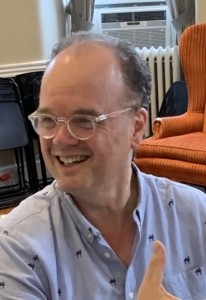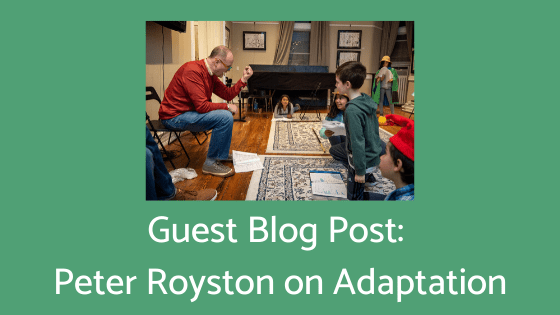Guest blog post: In adaptations, L’Engle valued capturing the essence of the original
By Peter Royston
In the book Literature Into Film, author Linda Costanzo Cahir writes, “Every act of translation is simultaneously an act of interpretation,” and that “Through the process of translation, a new text emerges — a unique entity — not a mutation of the original matter, but a fully new work.”
Madeleine L’Engle would be the first to acknowledge that the creation, or the incarnation, of new life, of “a unique entity,” grants the creator a great deal of power — but also a great deal of responsibility (to paraphrase Spider-Man!).
That responsibility comes down to choice: how do we as artists choose to adapt, to translate, original works?
“An artist is a nourisher and a creator who knows that during the act of creation there is collaboration. We do not create alone,” she wrote. That collaboration is usually between the audience and the creator but in the act of adaptation, another player comes into the mix: the original artist. Adaptation becomes a triangular collaboration between the adapter, the audience and the original creator. But how do we choose to face that collaboration? As an act of silent worship, or as an active conversation?
For L’Engle, choice is the most important part of being an artist, just as it is the most important part of being a religious person. By choosing, we fix order onto the chaos around us. In “Icons of the True,” (chapter 2 of Walking on Water) she writes that the non-believer “sees no cosmos in chaos, we are all victims of the darkness which surrounds our choices; we have lost our way; we do not know what is right and what is wrong; we cannot tell our left hand from our right.”
It is the artist’s job to make choices and therefore assign cosmos, or meaning, to chaos. Said another way, as she posits in A Wind In The Door, artists are Namers. She writes, “Stories are able to help us to become more whole, to become Named. And Naming is one of the impulses behind all art …When we name each other, we are sharing in the joy and privilege of incarnation, and all great works are icons of Naming.”
Cahir posits three different types of adaptation models: 1. Literal translation, in which the plot, dialogue and “all its attending details” are exactly as they are in the original text, 2. Traditional translation, where much of the overall plot of the original is there, but other changes have been made that the new creators feel are necessary, and 3. Radical translation, “which reshapes the book in extreme and revolutionary ways,” reinterpreting the original and making it more of its own “unique entity.”
If we had to label L’Engle’s opinions on adaptations, we can infer what L’Engle would have thought. She wrote that, “to serve any discipline of art … is to affirm meaning.” But comparing stories to the paintings of Icons of Eastern Orthodox artists, she wrote, “The figure on the icon is not meant to represent literally what Peter or John or any of the apostles looked like, nor what Mary looked like, nor the child, Jesus … The icon of Jesus may not look like the man Jesus two thousand years ago, but it represents some quality of Jesus, or his mother, or his followers, and so becomes an open window through which we are given a new glimpse of the love of God.”
For L’Engle, the “open window” for adapting artists was not through literal adaptation but radical translation. Why? Because far more important was the capturing of the quality or essence that gives us a “new glimpse” of the original. “An Icon is a symbol, not a sign,” she wrote.
Of course, an adapting artist must collaborate with her work with great humility. Like Meg in A Wrinkle in Time, artists need to appreciate their faults.
“We are human and humble and of the earth, and we cannot create until we acknowledge our createdness,” Madeleine said. We cannot Name unless we are Named.
Peter Royston is the Director of The Music Hall Academy, the performing arts/enrichment program of the historic  Tarrytown Music Hall in Tarrytown, NY. A theater educator and writer, Peter is the author of over 50 study guides for Broadway, Off Broadway and regional productions, including a series of lesson plans for the A Wrinkle in Time play adaptations at Stage Partners. Peter wrote the award winning history timeline for Actors’ Equity’s 90th Anniversary, and a resource guide on the artist Al Hirschfeld for the New York City Department of Education. He was also a writer on NYCBOE’s “Blueprint for the Arts” for Theater. Peter is currently working on a theatrical adaptation of Madeleine L’Engle’s A Wind In The Door.
Tarrytown Music Hall in Tarrytown, NY. A theater educator and writer, Peter is the author of over 50 study guides for Broadway, Off Broadway and regional productions, including a series of lesson plans for the A Wrinkle in Time play adaptations at Stage Partners. Peter wrote the award winning history timeline for Actors’ Equity’s 90th Anniversary, and a resource guide on the artist Al Hirschfeld for the New York City Department of Education. He was also a writer on NYCBOE’s “Blueprint for the Arts” for Theater. Peter is currently working on a theatrical adaptation of Madeleine L’Engle’s A Wind In The Door.
Do you have something you’d like us to share with our blog readers? We are taking submissions for guest blog posts. Email: social [at] madeleinelengle [dot] com


